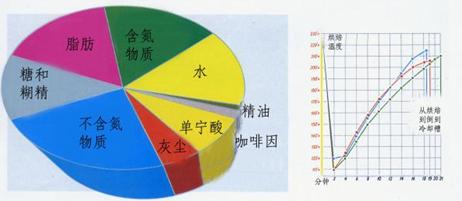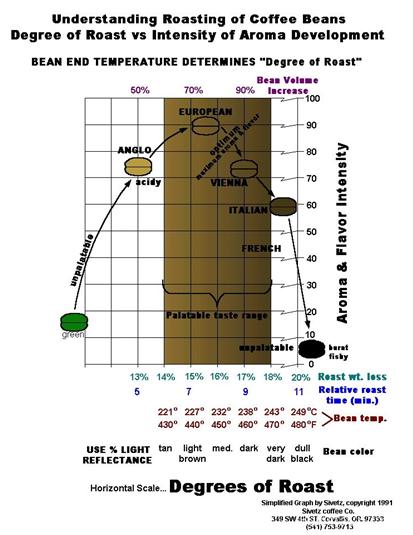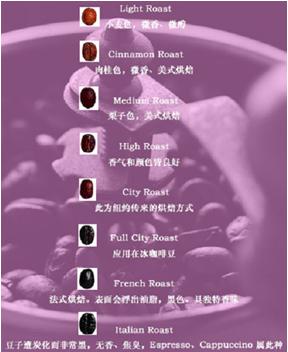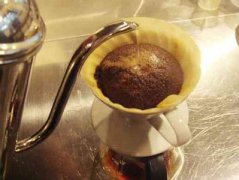Summary of training of Coffee Roasters with General knowledge of Fine Coffee
1. Mixing of coffee beans
Coffee from different origins needs to be pieced together for several different purposes. The ideal goal, of course, is to assemble a coffee that tastes better than any of them. But generally speaking, Arabica coffee from a single origin is enough to make a very good coffee; a light taste, a soft taste, and a sweet aftertaste. So there is no need to "mix"(that is, put together coffee from different origins).
The main commercial goal of coffee blending is to reduce costs and mix coffee that is not very good with coffee that tastes good. In order to increase sales profits. Another possible goal is to create a unique flavor, the unique flavor of a brand. Customers who like this taste will have to go to this manufacturer to buy, and cannot get it from other suppliers. Another advantage of this is that no matter how the coffee tastes in different years, the taste of the blended coffee will not change.
Here we ignore other possible commercial purposes, and concentrate on understanding the blending for the purpose of improving the taste quality of coffee.
Before mixing any coffee, first understand the taste characteristics of various coffees, and at least know in your heart that the coffee you want to mix will taste like no single coffee can achieve. It would be a shame if the coffee didn't taste better than one or more of them. It's better not to match. If you use coffee of some pretty good quality to make the mix, it's likely to be the case.
Although there are some fixed varieties of coffee that can be drunk directly as a single coffee, most of the coffee has more or less defects in flavor, such as no special flavor, lack of depth, insufficient strength or a certain taste is too strong. To make up for these deficiencies, several coffee beans with different characteristics should be combined to create a harmonious and deep taste. Some people think that the fun of coffee is focused on baking and mixing these two links, and drinking coffee is just enjoying your own victory. Blending coffee is not mixing coffee beans together casually. Sometimes the blending of two kinds of fine coffee will inhibit each other's unique flavor, so the blending is not simply a combination of several kinds of fine coffee. Just as a painter adjusts and creates attractive colors on a palette, a blender can also blend coffee beans to create attractive flavors. Therefore, it is not too much to say that matching is an art. As an artist, the matching division not only needs experience and inspiration, but also needs to pass certain scientific calculations. The creation of works of art is not accidental, but an explosion of long-term accumulation. A typical coffee blend does not have to use more than five coffee beans. Because if there are too many types of coffee beans, the situation can be very complicated. Almost only a very special expert would not be confused by so many different coffee beans.
II. Relationship between blending and baking
Coffee roaster training summary: is it first roast and then mix, or first mix and then roast? Which way is better?
If you have a definite recipe, of course the easiest way is to mix the different coffee beans together and bake them together. But if you're trying and comparing ingredients and ratios, you'd want to bake coffee beans before you try anything. Otherwise, every time you change the ingredients and proportions, you'll need to bake again.
For "Vienna coffee" blends and small test blends, it is more suitable for independent baking. For example, when a small amount of "roaster coffee" needs to be added in a trial mix, the required "roaster coffee" is most suitable for independent baking.
Some coffees are denser, or change in volume before and after baking, and these coffee beans are baked differently from "washed" Arabica coffee. Arabica coffee processed by the "drying method" is baked at a relatively high temperature. But in most cases, various coffee beans can be baked together.
Generally all coffee beans can be baked together. Consider baking independently only when baking results are not ideal. At this time independent baking can usually achieve better results. Especially for roller roasters, a relatively moderate baking degree can generally be found.
But some single-ingredient coffee beans are also not easy to bake evenly. For example, Yemeni coffee, Ethiopian DPcoffee beans, etc. An uneven baking color is not a defect, only "washed" Arabica coffee needs to be baked evenly.
General steps and principles of assembly
We should be clear about the following points before matching:
1. The theme of the selection
What kind of flavor do you want to mix, that is, determine the target of the mix.
2. Understand the characteristics of each coffee bean
To blend coffee, you must first understand the characteristics of each individual coffee and understand the subtle relationship between roasting degree and coffee flavor, which can only be achieved by tasting the cup.
3. Determine the tasks of coffee beans involved in blending
Since it is used with a variety of coffee beans, it is necessary to know the task of each coffee bean, whether it is to make her highlight soft bitterness, bright sourness or thick alcohol.
The following principles are generally followed when assembling:
1. Blending with the original beans requires the use of coffee beans with their own characteristics, and avoid the use of coffee beans with similar flavor. The selection of raw beans can be considered from three aspects:
Raw beans processing method: that is, raw beans are treated by washing method or drying method, and the processing method has a great relationship with the flavor of coffee beans.
Origin of raw beans: coffee origin is generally divided into three regions, including Central and South America, namely Brazil, Colombia, Guatemala, Mexico, Honduras, Jamaica, Peru and other about 20 countries; Southeast Asia, namely India, Indonesia (including Java and Sumatra islands), Papua New Guinea and other about 10 countries; Arabia and Africa, namely Ethiopia, Kenya, Tanzania, Arabia, Uganda and other about 25 countries.
Coffee bean flavor: refers to coffee bean flavor acid, bitter, sweet, alcohol which is more prominent, or all aspects of a more balanced neutral beans. The most commonly used beans are Brazilian, Colombia and mocha.
2. Number and proportion of coffee bean types involved in blending
Since it is a blending, it naturally refers to more than two kinds of original beans, but a special example is that the same coffee beans with different baking degrees can also be blended together, and even the new crop of the same coffee beans can be blended with aged coffee or oldcrop, so the type referred to in the blending is no longer a coffee variety in a narrow sense, but a broad extension to the flavor of coffee. 2~6 kinds of coffee beans are generally used when blending, too many kinds will not be able to express the unique flavor of coffee. Blending coffee generally does not adopt a blending ratio of 1:1, because this may inhibit each other's unique flavor, so there must be a primary and secondary point when blending in order to blend a more wonderful taste than single coffee. If you want to mix coffee with complex flavors, you can reduce the proportion of theme beans, and vice versa.
3. Blending coffee depends on trial and error, so a plan should be drawn up mathematically before blending, and then the best plan should be determined through the process of blending-tasting cup. Don't think this is a passive and stupid method. In fact, only the experience, inspiration and painstaking efforts of the blender can make a good cup of coffee.
3. Concept and principles of coffee baking
Roasting, as the name suggests, provides heat to coffee beans, causing a series of chemical changes to occur inside them. Coffee raw beans through baking, showing coffee unique color, flavor and taste. Each coffee bean contains fragrance, sourness, sweetness and bitterness. How to release it thoroughly depends on the baking temperature.
Roasting is an important step in the long journey of each coffee bean, from the tasteless raw bean to the lingering aroma of the cup. Coffee beans in this field for about 20 minutes (inversely proportional to the temperature), temperature as high as more than 200 degrees Celsius, in the process of intense dialogue with the fire, through many chemical changes. First of all, starch in raw beans will be converted into sugar and acidic substances due to high temperature, while cellulose and other substances will be carbonized to varying degrees. Water and carbon dioxide evaporate, and protein is converted into enzymes, which combine with the rest of the fat to form an oil film on the surface of the coffee bean. Coffee beans expand when baked, making a pop-like sound and losing moisture. But because the outer skin of coffee beans is very tough, we usually don't see coffee beans crack like popcorn. From raw beans, light baking, medium baking to deep baking, moisture is released again and again, weight is reduced, volume is slowly expanded, coffee beans color deepens, fragrant oil is gradually released, texture also becomes crisp.
Green beans contain a large amount of chloric acid, which gradually disappears during baking, releasing familiar and pleasant fruit acids such as acetic acid, citric acid and malic acid contained in wine. Baking is beneficial to present these acids in moderation.
We often see roasted coffee beans with different shades of color, on the one hand, this may be due to the different types of coffee beans; on the other hand, the main reason for this color difference is the degree of roasting. In the most colloquial language, the degree of roasting can be interpreted as the degree of heat at which it is baked. A classic example of carbon-fired coffee is French roast coffee, which, due to the depth of roasting (either due to the high temperature at which it is baked, or due to the long roasting time, or both, depending on the circumstances), is highly carbonized, with a dark brown surface and carbon black. It is generally believed that carbonized coffee tastes bitter, which not only comes from coffee, but more from carbonized coffee beans.
Principles of baking: The most important thing in baking is to be able to fry the beans evenly inside and outside. First of all, the water in the beans will be smoothly discharged through the fire. If this step is too hasty, it will have spots and taste astringent.
80% of the taste of coffee depends on roasting, so roasting is an important process for brewing good coffee. If the baking technique is good, the beans will be large and swollen, the surface will not be wrinkled, and the luster will be balanced. Roasting coffee beans to their ultimate character is the ultimate goal of baking.
Coffee flavor depends on the variety of coffee, baking is also a decisive factor.
Basically, coffee roasting is a high-temperature coking process that completely changes the substances inside the raw beans, producing new compounds and recombining them to form aroma and alcohol. This effect will only occur at high temperatures, if only low temperatures are used, it will not cause decomposition, and the coffee beans will not be cooked for a long time.
IV. Process and stage characteristics of coffee baking

Baking process
Most people think that baking is nothing, just frying the raw beans with fire. In fact, in the coffee process, baking is the most difficult step, it is a kind of science, but also an art, so in Europe and the United States, experienced bakers enjoy a highly respected status. Baking can be divided into the following three stages
1. Drying
In the early stage of baking, the raw beans begin to absorb heat, and the water inside gradually evaporates. At this time, the color gradually changed from green to yellow or light brown, and the silver film began to fall off, you can smell a faint smell of grass. The main function of this stage is to remove moisture, which accounts for about half of the baking time, because water is a good heat transfer conductor and helps to bake the internal material of coffee beans. Therefore, although the aim is to remove water, the baker will make good use of the temperature of the water and properly control it so that it will not evaporate too quickly; in general, it is best to control the water to reach the boiling point and turn into steam in 10 minutes. At this time, the internal material is fully cooked, and the water begins to evaporate, rushing out of the outside of the coffee bean.
2. High temperature decomposition
When baked to about 160C, the water inside the beans evaporates into gas and begins to rush out of the outside of the coffee beans. At this time, the interior of the raw bean changed from endothermic to exothermic, resulting in the first burst sound. After the popping sound, it turns to endothermic again, and the pressure inside the coffee bean is extremely high, up to 25 atmospheric pressure. Heat and pressure begin to deconstruct the original tissue to form new compounds that create the taste and taste of coffee; at about 190C, the transition between endothermic and exothermic occurs again. Of course, high temperature cracking continued to occur, coffee beans changed from brown to dark brown, and gradually entered the stage of re-baking.
3. Cooling
After baking, coffee must immediately cool, quickly stop the high temperature cracking, and lock the flavor. Otherwise, if the high temperature in the beans continues to work, the aromatic substances will be burned. There are two cooling methods: one is air-cooled and the other is water-cooled. The air-cooled type requires a lot of cold air and cools the coffee beans quickly within 3-5 minutes. In the field of professional baking, large roasters are equipped with a tray with a rotatable driving arm; when the baking is completed, the beans are automatically fed into the tray, and the fan at the bottom of the tray is immediately activated, blowing cold air, and the pushing arm stirs the coffee beans for cooling. Although the speed of the water-cooled type is slow, it is clean and non-polluting, and can better retain the fragrance and mellow of coffee, so it is used by the selected industry. The water-cooled method is to spray a layer of water mist on the surface of coffee beans, allowing the temperature to drop rapidly. As the amount of spraying water is very important, it requires precise calculation and control, and will increase the weight of baked beans, which is generally used in large-scale commercial baking.

Baking degree and characteristics
From the point of view of the baking degree, the deeper the baking degree, the stronger the bitter taste; the lighter the baking degree, the stronger the sour taste. The choice of baking degree depends on the characteristics of coffee beans. For coffee beans with strong bitter taste and light sour taste, they generally choose a moderate and shallow baking degree.
1. Shallow baking (Light)
The most mild fried culture, no fragrance and concentration to speak of, the beans are not yet ripe, with the green taste of raw beans, not suitable for grinding and drinking. It's usually used as an experiment.
2. Deep shallow baking (Cinnamon)
Also known as cinnamon baking, for the general popular degree of frying, leaving a strong sour taste. The color of beans is quite similar to that of cinnamon, so it is also called cinnamon baking and its sour taste is aggravated. It is favored by people in the western United States.
3. Shallow medium baking (Media)
Color deepening, easy to extract the original flavor of coffee beans, mellow, sour taste delicious. Mainly used for mixing coffee.
4. Medium baking (High)
Coffee has a stronger flavor and a lighter sour taste, which is the general baking method of coffee beans. The sour taste is neutralized and bitter, suitable for coffee such as Blue Mountain and Kilimanjaro. It is loved by Japanese and Nordic people.
5. Deep medium baking (City)
Also known as city baking, bitter taste is stronger than sour taste, almost no sour taste, unique flavor. Coffee, which is suitable for Colombia and Brazil, is very popular in New York.
6. Normal baking (FullCity)
Also known as city-wide baking, suitable for brewing ice coffee. No sour taste, mainly bitter taste, bitterness will be aggravated, but high-quality beans will have sweet taste. Used for ice coffee, favored by people in Central and South America.
7. French baking (French)
French baking method, slightly black color, strong bitterness, but also ooze oil, bitterness and concentration are deepened. Coffee for steam charger cooking.
8. Deep baking (Italian)
Also known as Italian baking, the deepest baking degree, the beans are black and bright, the surface is oozing oil, the bitterness is very strong. Coffee beans have been severely carbonized at this stage, and it is difficult to distinguish the taste of one coffee bean from another coffee bean. Used for Italian steam pressurized coffee.

Baking characteristics all over the world
Cities all over the world have their preference for frying and baking. In Tokyo, micro-deep medium baking is more popular, but slowly it also tends to deep baking. In the West, deep baking has been popular since ancient times. New York, as its name suggests, generally prefers urban baking, but because the city is inhabited by a variety of different races, it sells coffee beans with different degrees of baking. Vienna prefers deep baking. The French prefer French baking, while Italians often use Italian baking.
However, in recent years, Italian baking (the most commonly used deep roasting in Brazil and Italy) has been widely used in Europe and the United States, and the coffee cooked by steam pressurizer is still popular.
Deep baking of Ethiopian coffee beans would be a waste. Because that would lose the unique characteristics of this coffee. Black baking of Yauco and Kona coffee beans is also bad, because you will lose the classical flavor you pursue when you buy it.
Some coffee beans will have new and interesting qualities when roasted in black. Mexican coffee beans produce an interesting sweetness when roasted in black. Antigua coffee beans in Guatemala seem to retain their sour and fruity flavor when they are deeply roasted, which is difficult for other coffee. Sumatran coffee beans are usually full, but are below medium acidity, lose acidity when roasted deeper, and easily turn into sugar paste.
Generally speaking, the darker the baking, the lower the quality. Deeper baking means that most of the flavor of coffee beans will be lost.
Bake coffee beans at home
The hardest part of coffee-related activities is baking coffee beans at home. When adjusting high-quality coffee, it is very important whether the beans are fresh or not.
The easiest way is to bake coffee beans in the oven. The biggest advantage of this is that it can adjust the temperature so that the smell of grilled coffee will not permeate your home. Heat the oven to 230 degrees in advance. Remember to keep the coffee beans well ventilated and don't spread the beans too thick. After baking for about 10 minutes, observe the change of color. Pay attention to the crackling sound of coffee beans and check the color all the time. When the coffee beans are only a little lighter than you want, remove them from the oven to cool. The waste heat will keep the coffee beans heated for 4 minutes.
Home baking stoves can also be used, but the best is the traditional flat-bottomed pan or popcorn (popcorn) model. Use a handle to manipulate two vertical pieces of metal inside the machine that rotate the coffee beans during baking. This can be bought in a second-hand store or a good kitchen utensils store, where you can also buy inexpensive oven thermometers.
After the coffee has baked, take them out of the grill, put them into a heat-resistant bowl, and place the bowl by the window or outdoors. The operation of crushing baked coffee beans into powder is called grinding. The props for grinding coffee beans are called grinders. The ideal time to grind coffee is before cooking. Because the powdered coffee is easy to oxidize and lose its fragrance, especially without proper storage, the coffee powder is easy to change flavor and cannot be cooked into mellow aroma.
Some people are afraid of trouble or do not want to buy more bean grinders, usually drink coffee at home to buy ready-made coffee powder, when you should pay special attention to the storage problem. If the climate is humid, it is best not to place coffee powder at room temperature after opening. A more appropriate way is to put it in a sealed jar and refrigerate it, and do not place it with garlic, fish and shrimp and other heavy-flavored food. Because coffee powder is easy to absorb, one accidentally becomes a strange-smelling coffee, then no matter how good the quality of coffee is ruined. However, some people put cooked coffee powder in the refrigerator as deodorant, which is a good way to make the best use of things.
When grinding beans, the size of the powder depends on the way it is cooked. Generally speaking, the shorter the cooking time, the finer the ground powder; the longer the cooking time, the thicker the ground powder. In the way of actual cooking, the time required for ESPRESSO machine to make coffee is very short, so the grinding is the finest, and coffee powder is as fine as flour; it takes more than a minute to cook coffee with plug air, and coffee powder is medium-sized grinding; American filter drop coffee takes a long time to make, so coffee powder is the thickest.
Grinding coffee powder with proper thickness is very important for making a good cup of coffee, because the extraction of water-soluble substances in coffee powder has its ideal time. If the powder is very fine and cooked for a long time, resulting in excessive extraction, coffee may be very bitter and lose its aroma. On the other hand, if the powder is too coarse and cooked too fast, resulting in insufficient extraction, then coffee will be insipid because there is no time to dissolve the water-soluble substance in the powder.
Important Notice :
前街咖啡 FrontStreet Coffee has moved to new addredd:
FrontStreet Coffee Address: 315,Donghua East Road,GuangZhou
Tel:020 38364473
- Prev

High-quality coffee common sense coffee cup test Cupping Tasting
Recently, I saw many cafes holding Cupping activities, which attracted a large number of coffee lovers to participate enthusiastically. Seeing that the coffee industry is so prosperous and coffee lovers are so studious, I can't help feeling comforted that the efforts of coffee people have not been in vain. But in the case of Cupping, is it a sign of professionalism or a gimmick for businesses to attract customers? I hope you will have one after reading this article.
- Next

Basic knowledge of Fine Coffee coffee Grinding equipment
There are different brands and models of bean grinder, and the grinder which can adjust the thickness of grinding bean is ideal. When grinding with a bean grinder, don't grind too much at one time, just enough for one use. Because the longer the bean grinder is used at one time, the easier it is to heat up, which indirectly causes the coffee beans to be heated and leads to the loss of aroma, thus affecting the aroma of coffee. Coffee beans contain oil lu.
Related
- Beginners will see the "Coffee pull flower" guide!
- What is the difference between ice blog purified milk and ordinary milk coffee?
- Why is the Philippines the largest producer of crops in Liberia?
- For coffee extraction, should the fine powder be retained?
- How does extracted espresso fill pressed powder? How much strength does it take to press the powder?
- How to make jasmine cold extract coffee? Is the jasmine + latte good?
- Will this little toy really make the coffee taste better? How does Lily Drip affect coffee extraction?
- Will the action of slapping the filter cup also affect coffee extraction?
- What's the difference between powder-to-water ratio and powder-to-liquid ratio?
- What is the Ethiopian local species? What does it have to do with Heirloom native species?

